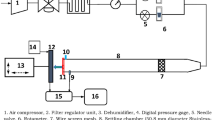Abstract
Flow-induced oscillation is an effective way to enhance heat transfer, which requires no extra energy consumption and can prevent fouling and soot formation. To test the flow-induced oscillation effect on the heat transfer of impingement flow, an 18 mm wide and 30 µm thick membrane tape was mounted at the exit of the ejection pipe. As the ejection Reynolds number increased from 5280 to 9827, the oscillating frequency also increased. In addition, three different oscillating regimes were observed, these being quasi-still, 2D-oscillating and 3D-oscillating, with the transition Re depending on the tape length. The heating plate was 3D-printed and electrical heating wires were embedded within it so as to predetermine the local heat flux by numerical analysis, and be able to calculate the heat transfer coefficient (HTC). The results demonstrate that heat transfer enhancement is more prominent in the vertical direction to the tape than in the parallel direction. Moreover, the distinctive heat transfer enhancement effect near the plate center becomes weaker as it goes toward the outside of the plate, and even turns negative with an increasing r/D. Using a longer piece of tape or having smaller intervals between the tape tip and plate was also shown to improve the heat transfer effect. The spontaneous oscillating disturbance method shows great promise for heat transfer regulation in impingement flow.
Similar content being viewed by others
References
A. Sadeghianjahromi and C.-C. Wang, Renew. Sust. Energ. Rev., 137, 110470 (2021).
R. L. Webb, Principle of enhanced heat transfer, Wiley, New York (1994).
S. Ghanami and M. Farhadi, Protein Sci., 7(1), 9 (2019).
R. Hassan, P Roy Soc Lond A Mat, 277(1368), 51 (1964).
P. R. Owen, J. Mech. Eng. Sci., 7(4), 431 (1965).
K. Lam, G. D. Jiang, Y. Liu and R. So, Int. J. Numer Methods Fluids, 46(3), 289 (2004).
N. Zhang, Adv. Mat. Res., 542–543, 66 (2012).
D. Duan, P. Ge and W. Bi, Energy Convers. Manag., 103, 859 (2015).
K. A. R. Medeiros, F. L. A. de Oliveira, C. R. H. Barbosa and E. C. de Oliveira, Measurement, 91, 576 (2016).
O. O. Ajayi, M. C. Agarana and T. O. Animasaun, Procedia Manuf., 7, 602 (2017).
L. Cheng, T. Luan, W. Du and M. Xu, Int. J. Heat Mass Transf., 52(3), 1053 (2009).
M. H. Mousa, N. Miljkovic and K. Nawaz, Renew. Sust. Energ. Rev., 137, 110566 (2021).
P. Hidalgo, F. Herrault, A. Glezer, M. Allen and B. S. Rock, Thermal Investigations of ICs and Systems (THERMINIC), 2010 16th International Workshop on (2010).
F. Herrault, P. A. Hidalgo, C. Ji, A. Glezer and M. G. Allen, 2012 IEEE 25th International Conference on Micro Electro Mechanical Systems (MEMS), 1217 (2012).
J. Ryu, S. G. Park, B. Kim and H. J. Sung, J. Fluids Struct, 57, 159 (2015).
G. Krishan, K. C. Aw and R. N. Sharma, Appl. Therm. Eng., 149, 1305 (2018).
L. Yong and M. C. Xiao, Eur. J. Mech. B Fluids, 57, 40 (2016).
L. Agricola, R. Prenter, R. Lundgreen, M. Hossainf and J. Bons, 53rd AIAA/SAE/ASEE Joint Propulsion Conference (2017).
T. Park, K. Kara and D. Kim, Int. J. Heat Mass Transf., 124, 920 (2018).
M. Germano, U. Piomelli, P. Moin and W. H. Cabot, Phys. Fluids A, 3(7), 1760 (1991).
P. Chorin, F. Moreau and D. Saury, Int. J. Therm. Sci., 161, 106711 (2020).
M. Holger, Adv. Heat Transf., 13, 1 (1977).
C. Camci and F. Herr, Int. J. Heat Mass Transf., 124(4), 770 (2002).
M. A. Hossain, L. Agricola, A. Ameri, J. W. Gregory and J. P. Bons, 2018 AIAA Aerospace Sciences Meeting (2018).
Acknowledgements
The authors would like to extend their sincere gratitude to National Natural Science Foundation of China (51806128 and 51879154), Natural Science Foundation of Shandong Province (ZR2019BEE008 and ZR2019MEE007) and China Postdoctoral Science Foundation (2020M682211).
Author information
Authors and Affiliations
Corresponding author
Rights and permissions
About this article
Cite this article
Qu, X., Qi, X., Guo, Q. et al. Influence of flow-induced oscillating disturbance on the surface heat transfer of impingement flow. Korean J. Chem. Eng. 38, 2217–2228 (2021). https://doi.org/10.1007/s11814-021-0879-0
Received:
Revised:
Accepted:
Published:
Issue Date:
DOI: https://doi.org/10.1007/s11814-021-0879-0




